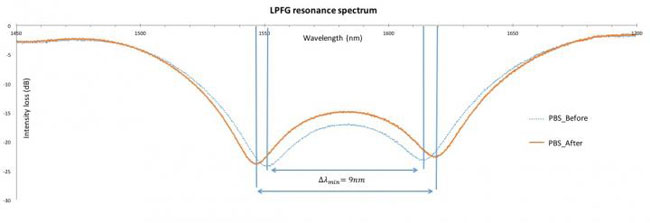
Sensor Can Find E. coli Quickly Over Wide Temperature Range
A fiber-optic biosensor has been developed that can detect E.coli bacteria in 15 to 20 minutes. The sensor is temperature-insensitive over a wide range, making it well-suited for the accurate detection of E. coli bacteria in outdoor environments.
To build the sensor, bacteriophages were bonded to the surface of an optical fiber. The bacteriophages grab E.coli bacteria from a sample and keep the bacteria attached to the fiber. When a beam of light strikes the sensor’s surface, its wavelength shifts when E. coli is present, indicating E.coli contamination.

The graph shows the shift of the sensor spectrum after catching bacteria. Courtesy of Wojtek J. Bock.
Using optical fibers for bacteria detection can be challenging because temperature changes can alter the optical properties of the materials. Existing methods to resolve temperature cross-sensitivity can require a custom design, increasing sensor and detection unit cost; and can reduce refractive index sensitivity due to overlay coating.
The research team, from the University of Quebec and the Indian Institute of Technology Kanpur, maximized the surface sensitivity of the sensor by operating the long-period fiber grating (LPFG) closest to its turnaround wavelength. The team compensated for the temperature-induced phase changes of LPFGs by selectively exciting a pair of cladding modes with opposite dispersion characteristics by means of optimized concatenated LPFGs. The principle and methods used to obtain the temperature insensitivity could be used in the design of various temperature-insensitive fiber-optic devices based on LPFGs.
The team conducted experiments to detect various concentrations of E. coli bacteria in water kept at different temperatures. They observed a slight fluctuation of about 0.1 nm in the resonance wavelength, which could be attributed to the noise associated with the source at higher wavelengths. Spectral shifts ranging between 1.3 and 2.5 nm were observed with changing bacterial concentrations.
The sensor is able to detect an index variation of about 5×10−6 refractive index units in the ambient refractive index using a detection system with a resolution of 10 pm, with a negligible temperature sensitivity of −1.25 pm/°C over a temperature variation of 40 °C.
The sensor’s temperature insensitivity makes it potentially valuable for outdoor applications like the on-site monitoring of reservoirs. The sensor can be modified to detect other strains of bacteria by changing the bacteriophage. The overall length of the sensor is about 3.6 cm, making it suitable for biosensing applications.
"Using currently available technologies, which are mostly based on amplification of the sample, it takes several hours to days to detect the presence of bacteria. A fast and accurate detection alternative is, therefore, preferable over the existing technology," said Saurabh Mani Tripathi, a physicist at the Indian Institute of Technology Kanpur. "Faster tests for the bacteria could lead to faster treatment of patients, as well as to cheaper and easier environmental monitoring."
The research group is currently collaborating with Security and Protection International Inc., a Canadian company, to explore commercialization of their device.
The research was published in a publication of OSA, the Optical Society of America (doi: 10.1364/OL.41.004198).
Published: September 2016